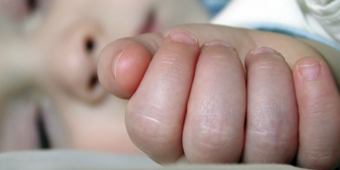Baby’s First Workout: Tummy Time

Answer a few questions and we'll provide you with a list of primary care providers that best fit your needs.
It’s commonly said that all newborn babies can do is eat, sleep and poop. But this isn’t true. Your baby also can work out, and you need to prioritize his exercise just like you do yours. Newborns work out through tummy time, when you place your baby down on the stomach on a comfortable, firm surface while you’re watching him. This gives him the opportunity to strengthen his neck, back and arms.
Why Tummy Time?
Developmentally, your baby needs tummy time to build his muscles so that he can roll over and eventually sit up (and then, before you know it, get on the move!). Before the early 1990s, parents generally put their babies down to sleep on their stomachs. When the American Academy of Pediatrics started the “back to sleep” initiative, infant deaths from SIDS (sudden infant death syndrome) went down by half. But many babies also started not getting enough time on their tummies to strengthen those important muscles. And, they started having issues with flattened heads. So, doctors and experts began encouraging “Back to sleep. Tummy to play.”
How Much Tummy Time Is Enough?

When you come home from the hospital, start laying your baby down on his tummy two to three times per day for three to five minutes. You can lay him on a soft blanket or quilt, but make sure that it stays put when your baby moves on it (you don’t want it to get all rumpled in his face). A good time for tummy time is when he’s wide awake after a diaper change. You want to gradually lengthen the time as your baby grows older, until he’s up to around 15 to 20 minutes per day. But always remember that you need to be there keeping watch and keeping him happy.
Developmentally, your baby needs tummy time to build his muscles so that he can roll over and eventually sit up (and then, before you know it, get on the move!).
What If My Baby Doesn’t Like Tummy Time?
While some babies seem to enjoy their first workout, others really hate tummy time. Here are some tips to help make it more enjoyable for both you and your baby:
- Start early. The day you get home from the hospital, this should become part of your routine. It’s much better than waiting a few weeks and then introducing your baby to tummy time right as he is starting to get a hang of life in the big, wide world.
- Get on the floor with him. Your baby loves you and being with you. So, in his opinion, anything with you as close as possible is the right choice.
- Try tummy to tummy time. Your baby may enjoy laying on your tummy. This can even be a two-for-one deal if you make it skin-to-skin. You can play games with your baby as he is on your tummy. Do a few crunches and play peek a boo.
- Try putting an unbreakable mirror on the ground. He may love looking down at his face.
- Use a pillow. Put something like a nursing pillow under his arms, so that he can be propped up and have a better view.
- Find his favorite toys. This is a good time to figure out what kind of little toys are appealing to him. Entice him to stay longer and longer with tummy time by only bringing out those toys then!
Anything Else I Need to Remember?
Though it’s already been mentioned, you have to remember these two things: First, “back to sleep and tummy for play.” It’s never safe to let your baby sleep on his stomach, even if he falls asleep during tummy time and looks so comfortable and cute. Move your baby onto his back to sleep.
Secondly, always remember that you need to be there during tummy time. Do not put your baby down and leave the room. Watch and play – let this be a sweet little time where you get to keep bonding with your new baby.
Answer a few questions and we'll provide you with a list of primary care providers that best fit your needs.
Source: What to Expect; healthychildren.org




